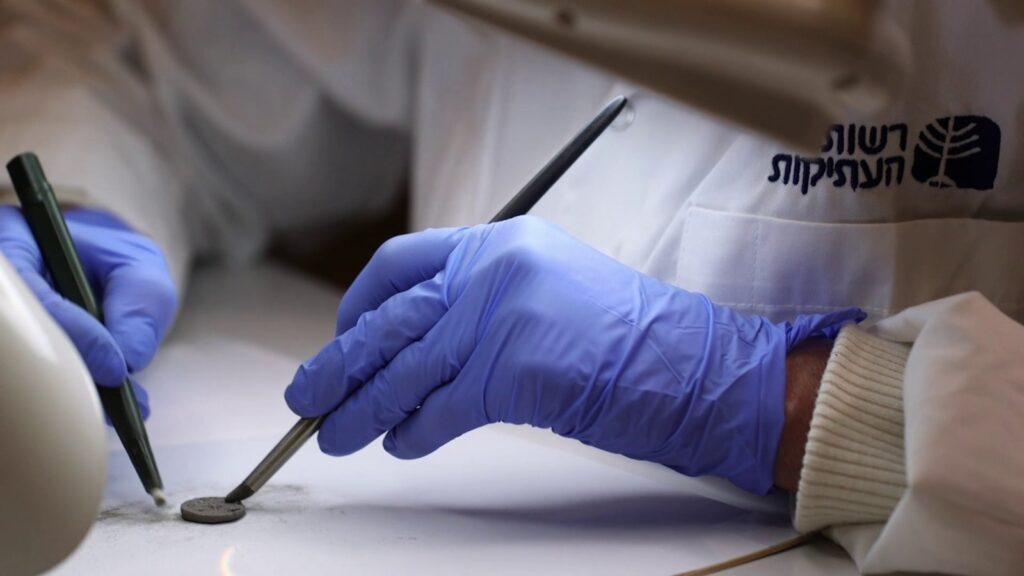
Rare silver half-shekel coin from Judean Revolt found in Ein Gedi cave
A rare silver half-shekel coin inscribed with the words “The Holy Jerusalem” in Hebrew and dated to 66/67 CE was discovered in the Ein Gedi nature reserve in the Judean Desert.
The coin was found at the entrance of a cave on a cliff in a wadi (dry valley) near Ein Gedi. The search was part of an effort by the Israel Antiquities Authority (IAA) together with the Heritage Ministry and the staff officer of the Civil Administration Archaeology Unit in Judea and Samaria to combat antiquities theft. Over the last six years, these government organizations have worked to retrieve antiquities before any looters find them. This requires examining every nook and cranny in the regions that might contain antiquities.
The coin dates to the first year of the First Jewish Revolt against the Romans. Researchers believe the coin fell from the pocket of a rebel who escaped to the desert during the revolt – perhaps on his way to nearby Ein Gedi.

On one side of the coin is an inscription of the coin’s value, together with the ancient Hebrew letter aleph marking the coin‘s minting as the first year of the outbreak of the Revolt. This side of the coin also depicts a goblet. The opposite side of the coin bears the inscription: “Holy Jerusalem.” The word “Holy” is spelled without a vowel, reflecting the development of Hebrew writing. On coins that were minted later in the Revolt, the word “Holy” appears with the vowel.
During the revolt, the Jews in Jerusalem minted both bronze and silver coins. Silver coins were minted at that time in shekel weight, half shekel, and quarter shekel weight in Judea between the years 66 to 70 CE. Minting coins independent of the Romans was considered an act of defiance by the Jewish revolutionary government. At the time, the authority to mint coins was held only by the Roman emperor.
The coins, weighing about seven grams, depicted ancient Hebrew script from the First Temple Period, which was no longer in use. This contrasted with the Greek language, which was used by the Jewish population at the time of the Second Temple.
The coins depicted Jewish symbols also as an act of defiance since the Roman coins featured the image of the emperor.
Yaniv David Levy, the IAA’s numismatic scholar, explained that it is rare to find these coins. A similar coin discovered last year was described as the third such coin of its type found during excavations in Jerusalem and one of the few ever found in archaeological excavations anywhere.
They served a specific ritual purpose for the Jews as every male above the age of 20 had a Biblical requirement to contribute a half shekel of silver to the Temple every year.
This is what everyone who is entered in the records shall pay: a half-shekel by the sanctuary weight—twenty giera to the shekel —a half-shekel as an offering to Hashem. Exodus 30:15
Amir Ganor, a director of the Judean Desert Survey and Excavation Project, noted that “the find of the silver Year-One half-shekel in the course of a controlled archaeological activity is a rare event in Israel and in the Judean Desert in particular.

Historians believe that for 200 years, tetradrachms minted in Tyre were used to fulfill this mitzvah. Phoenician coins from the city of Tyre, now part of Lebanon, they were used in the Roman Empire from 126 BCE until 56 CE. They bore the Greek inscription “ΤΥΡΟΥ ΙΕΡΑΣ ΚΑΙ ΑΣΥΛΟΥ” Tyrou hieras kai asylou, “of Tyre the holy [city] and [city] of refuge”. One side of the coins bore the likeness of the Phoenician god Melqart, also known as Baal, who was worshipped by the Greeks as Herakles. The Jews derided the God under the name Beelzebub. While these coins were chosen for their silver’s purity, they were also problematic because they bore the image of Tyrean gods.
After the Roman Empire closed down the mint in Tyre, the Roman authorities allowed the Jews to continue minting Tyrian shekels in Judaea, but with the requirement that the coins should continue to bear the same image and text to avoid objections that the Jews were given autonomy. They were replaced by the First Jewish Revolt coinage in 66 CE.
The post Rare silver half-shekel coin from Judean Revolt found in Ein Gedi cave appeared first on Israel365 News.
Israel in the News